| |
STRATIGRAPHY AND DEPOSITIONAL ENVIRONMENT
Cretaceous exposures of the North Carolina Coastal Plain extend roughly from I-95 to (and growing younger as they approach) the coast. Traditionally, the Cretaceous deposits of North Carolina were viewed as being made-up of four formations -- Cape Fear, Middendorf, Black Creek and Peedee. Depending on the author, the basal Cape Fear ranged from Barremian (Lower) to Cenomanian (Upper Cretaceous) with the other formations sharing, to various degrees, the remaining years to the KT. Owens & Sohl (1989) significantly changed the understanding of these sediments and their depositional environment. They ascribed the Cape Fear to the Coniacian, Middendorf to the Santonian, changed the status of the Black Creek to Group and limited the Peedee to late Maastrichtian. Three former members of the Black Creek were raised to formation status - the Tar Heel (Early Campanian), Bladen (Late Campanian) and Donoho Creek (Early Maastrichtian); Sohl & Owens (1991) furthur clarified this revision. Weems et al (2004) reflected additional adjustments of these units. The Black Creek Group was limited to the Campanian and the Santonian units included the Cape Fear & Pleasant Creek Formations.
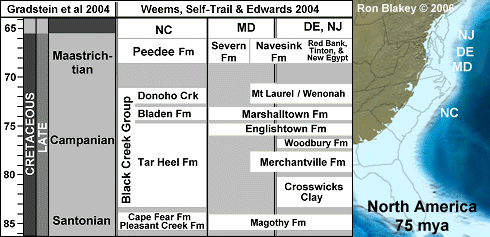 |
| Correlation chart integrated by Jim Bourdon 2007. Paleomap reproduced with the permission of Dr. Blakey 2007. |
To all but the most serious student, the lower two (western most exposures) members are of little interest. According to Carter, et al. (1988), the sandstones and mudstones of the Cape Fear, which originated in lagoonal, estuarine and marine environments, yield only pollen to the collector. The river deposits, primarily sands, sandstones and mudstones, of the Middendorf Formation contain larger plant material as well - silicified wood and fossil leaves.
Formations of the Black Creek Group (river delta) and the Peedee (open marine) are the source of most North Carolina Cretaceous fossils. Owens & Sohl (1989) extensively describe the Black Creek Group tracing its delta-shelf depositional environment and the resulting facies by location. In general, the environment of each formation is relatively similar; delta plain to the southwest, shelf to the northeast. The sands and clays of the upper delta plain tend to be largely un-fossiliferous. The facies then change to black, carbonaceous clays interbedded with white/buff micaceous sands and produce plant material. These are followed by interbeds of clay and glauconitic quartz sand, which yield plant & invertebrate material. Upper deposits become dark sands and clays with coarser sands, phosphatic and gravel layers and occasional sandstone lenses.
According to Carter, et al. (1988), the Peedee Formation of the southeastern Coastal Plain is made up of massive sands and limestones, which can be quite fossiliferous and include invertebrates, phosphatic bones & teeth and plant material. In the Wilmington, NC area, the upper Peedee is made-up of quartz sandstone and sandy limestone.
CHONDRICHTHYAN FAUNA
Of primary relevance to this website are the sediments that produce vertebrate material, particularly sharks and rays - consequently the discussions will be limited to the Black Creek Group and Peedee Formation. Intended only to be a quick overview of the NC Cretaceous, the units that comprise the Black Creek Group will "lumped" together for discussion purposes. The authors, unless otherwise noted, collected all listed species or discussed specimens.
The Black Creek Group
In most cases, the best vertebrate collecting in these units occurs in gravel lenses that concentrate reworked phosphatic material. Productive exposures yield large numbers of teeth and other fossils, particularly if a fine screen is employed. The relative abundance as discussed by the authors is based on the off-site processing of finer material. In addition to the chondrichthyan material featured in the below list, normal collecting results include a number of other fish (Enchodus, Anomoeodus, Albula, Paralbula, etc.) and reptile teeth.
Peedee Formation
Neither of the authors has extensive experience working the Peedee, but isolated encounters have occurred while working the overlying Eocene. These opportunities have been limited to surface-collecting, therefore no assessment can be made of the species yielding smaller teeth (particularly the rays). Rome Lytton has provide a Peedee Fauna from Lake Waccamaw, NC.
| | | | |
| CLICK ON IMAGES FOR ADDITIONAL DETAILS
|
| HYBODONTIFORMES |
 |
Hybodus sp — extinct family of hybodont sharks
Tooth fragments common in Black Creek sediments, complete crowns rare, dorsal spines uncommon.
Robb (1989) lists H. montanensis CASE 1978 as present
in the Black Creek sands. |
 |
Lissodus sp - extinct family
Common in certain Black Creek sediments when finer material evaluated. Most specimens lack
roots and the crowns are water worn. This specimen compares well with L. selachos.
but is most likely L. babulskii |
| SQUATINFORMES |
 |
Squatina hassei
LERICHE, 1929 — angel shark
A regular component of a day's Black Creek "take", but roots are rarely in good condition. |
| ORECTOLOBIFORMES |
 |
Cantioscyllium cf decipens
WOODWARD, 1889 — nurse shark
When processing finer material from Black Creek Group, these teeth can be deemed common. |
 |
?Ginglymostoma globidens
(CAPPETTA & CASE, 1975) — nurse shark
An uncommon tooth in the Black Creek Group, and when found, roots are "shot".. |
 |
Plicatoscyllium minutum
(FORIR, 1887) — Extinct nurse shark
Another uncommon tooth in the Black Creek Group which usually have very worn roots.
[Labial notch caused by damage.] (Formerly Ginglymostoma lehneri)
|
| LAMNIFORMES |
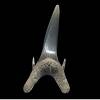 |
Carcharias holmdelensis (CAPPETTA & CASE, 1975)
and Carcharias samhammeri (CAPPETTA & CASE, 1975)
— sandtiger |
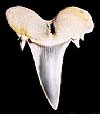 |
Scapanorhynchus texanus
(ROEMER, 1849) — goblin shark
The teeth of this species are found in the Peedee and abundant in the Black Creek Group. |
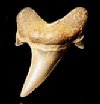 |
Archaeolamna kopingensis
(DAVIS, 1890) — mackerel shark
Formerly referred to as Plicatolamna arcuata or more recently, Cretodus
arcuatus, teeth from this species are common in Black Creek sediments and
listed by Case (1979) as probably present in the Peedee. |
 |
Cretalamna appendiculata (AGASSIZ, 1843)
— mackerel shark
Common in North Carolina as in other East Coast Cretaceous locales. |
 |
Cretalamna biauriculata ARAMBOURG, 1935
— mackerel shark
Teeth of this design appear to be relatively common in
the Peedee. Questionable examples found in Black Creek sands. |
 |
Serratolamna serrata (AGASSIZ, 1843)
— mackerel shark
A common tooth in the Black Creek sands (Tar Heel & Bladen) and Peedee Formation. |
 |
Squalicorax kaupi (AGASSIZ, 1843)
— crow shark
Abundant in Black Creek sands and Peedee Formation. |
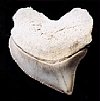 |
Squalicorax pristodontus (AGASSIZ, 1843)
— crow shark
Common in Black Creek sands and Peedee formation. Peedee specimens often large and in exceptional condition. |
 |
Squalicorax ?bassanii (GEMMELLARO, 1920)
— crow shark
Commonly referred to as S. bassanii, features of these teeth suggest an alternate identification
is possible (see genus page). |
| RAJIFORMES |
 |
Pseudohypolophus cf mcnultyi (THURMOND, 1971
— extinct ?guitarfish.
Abundant in Campanian Black Creek sands, but roots often gone or significantly worn |
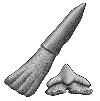 |
Ischyrhiza mira LEIDY 1856
— extinct sawfish family
Rostral and oral teeth common in Black Creek sands. (Oral teeth require
close examination of sand/gravel offsite.) |
 |
unidentified sawfish rostral spine
Uncommon specimen from Black Creek sands. |
 |
Ptychotrygon vermiculata
CAPPETTA, 1975 — extinct sawfish family
Abundant species in Black Creek when finer material is studied |
| MYLIOBATIFORMES |
 |
Brachyrhizodus wichitaensis
ROEMER, 1942 — extinct ray genus
Specimens common in Black Creek sands, usually quite worn. |
 |
Rhombodus levis
CAPPETTA & CASE 1975 — extinct ray genus
Worn teeth from this species are common in the Black Creek sands. |
 |
Rhombodus binkhorsti DAMES 1881
— extinct ray genus
Reported by Case (1979) as present in the Peedee Formation. |
REFERENCES
Carter, J., Gallagher, W. Enos Valone, R., and Rossbach, T., 1988. Fossil Collecting in North Carolina, North Carolina Geological Survey. 89pp.
Case, G., 1979. Cretaceous Selachians from the Peedee Formation (Late Maestrichtian) of Duplin County, North Carolina, Brimleyana, Vol 2, pp 77-89.
Gradstein, F., Ogg, J. & Smith, A., 2004, A Geological Time Scale 2004. Cambridge University Press. 589pp.
Owens, J. and Sohl, N., 1989. Campanian and Maastrichtian Depositional Systems of the Black Creek Group of the Carolinas, North Carolina Geological Survey. 23pp.
Robb, A., 1989. The Upper Cretaceous (Campanian, Black Creek Formation) Fossil Fish Fauna of Phoebus Landing, Bladen County, North Carolina, The Mosasaur, Vol 4, pp 75-92.
Sohl, N. and Owens, J., 1991. Cretaceous stratigraphy of the Carolina coastal plain, IN Horton, J., Jr., & Zullo, V., eds., The geology of the Carolinas: Carolina Geological Society, 50th Anniversary Volume, p. 191-220.
Weems, R., Self-Trail, J. & Edwards, L., 2004, Supergroup Stratigraphy of the Atlantic and Gulf Coastal Plains (Middle? Jurassic through Holocene, Eastern North America). Southeastern Geology 4:2, USGS pp191-216.
Although NC Cretaceous exposures are widespread and productive, there are few "walk on sites" readily
accessible to, or collectable by, the casual visitor. Those seriously interested in collecting these exposures
would be advised to do so with an established Paleo-club. The
North Carolina Fossil Club
regularly visits sites throughout the state.
If you can provide feedback or help us with this effort, contact:
Jim Bourdon or
Kim Greene
|